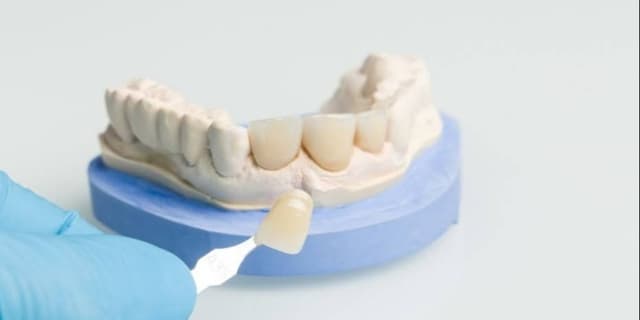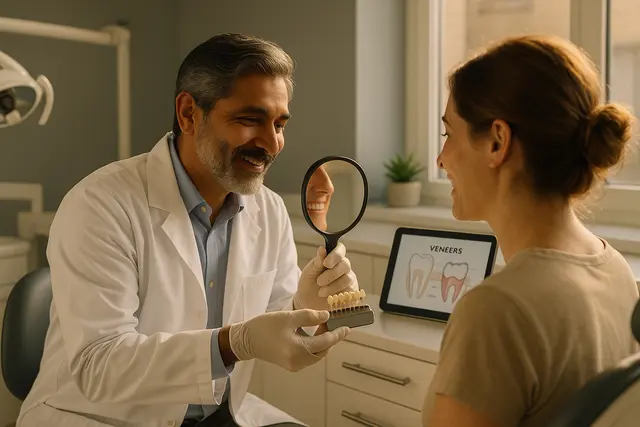Cosmetic Dentistry
5 min read
Mar 20, 2025
Veneers Procedure: Step-by-Step Timeline & Recovery Tips
Veneers are custom-made, thin shells bonded to the front of teeth to address discoloration, chips, gaps, or misalignment. Common types include porcelain (lasting 10–15 years) and composite resin (5–7 years). No-prep or removable options exist but are less durable.

The Basics: What Are Veneers and Why Do People Get Them?
A veneer is not some mystical dental cloak. It’s a wafer-thin shell, usually made from porcelain or composite resin, that’s bonded to the front surface of your tooth. Veneers are often used to fix cosmetic concerns like chipped enamel, gaps between teeth, crooked teeth, discolored teeth, or misshapen/malformed teeth with irregular shapes. Veneers are a cosmetic solution that instantly upgrades your smile without completely reworking your mouth. And because veneers cover only the front surface of the tooth, they offer a subtle but powerful improvement.
What Happens Before the Procedure: Consultation and Candidacy
Before a veneer ever touches a tooth, your dentist will examine your teeth and gums to make sure you're a good candidate for veneers. Good oral health is key, if you have gum disease or tooth decay, those need to be treated first. Your dentist might take X-rays or digital scans, discuss your goals, and walk you through the different types of veneers available: traditional porcelain veneers, composite resin veneers, removable veneers like snap-on veneers, or even no-prep veneers for less invasive treatment.
Preparing Your Teeth: Shaping, Etching, and Temporaries
If you're going with traditional veneers, the first step involves removing a tiny bit of enamel to make space. This typically involves removing 0.3 to 0.7 mm of enamel, depending on the tooth’s anatomy and the veneer design, so the veneer doesn’t look bulky once it’s bonded. After that, your dentist will etch the surface of the tooth so the veneer can bond securely. Impressions or digital scans are taken and sent to a dental laboratory, where your custom veneers are crafted. While you're waiting, temporary veneers may be placed to protect the exposed tooth and help you preview your new smile.
The Day of Transformation: Fitting and Placing Your Veneers
When your permanent veneers arrive (usually after 1–2 weeks), your dentist checks the color, fit, and shape against your natural teeth. If everything looks great, the dentist will clean your teeth thoroughly, etch the surface again, and apply a bonding agent. Each veneer is placed using dental cement, then cured with a special light that hardens the bond within seconds. Excess cement is trimmed off, and your bite is adjusted if needed. Smooth and polish the veneer to look like your natural tooth.
Porcelain vs. Composite Resin: Which Veneer Material is Right for You?
Porcelain veneers are often seen as the gold standard. They're stain-resistant, mimic the natural translucence of enamel, and veneers can last 10 to 15 years with proper care. Composite veneers, on the other hand, can be sculpted directly on the tooth in a single visit. They're more budget-friendly and easier to repair, though they tend to discolor over time and aren’t as long-lasting as their porcelain veneers. Your dentist will help you weigh the pros and cons of porcelain or composite resin depending on your goals, budget, and how many veneers you need.
What to Expect After Veneer Placement: Sensitivity and Recovery Tips
Immediately after getting veneers, some patients notice a little sensitivity to hot or cold. That’s normal, your enamel was slightly trimmed, after all. Most of the sensitivity fades within a week. During the first 24 hours, avoid very hard, crunchy, or sticky foods that could disturb the cement while it's settling. Don’t panic if things feel “different”, your mouth will adjust.
Here’s a quick recovery checklist to help:
Stick to soft foods on day one
Brush gently with a non-abrasive toothpaste
Floss daily (yes, even around the veneers)
Avoid biting directly into very hard items, such as pencils or ice
Wear a night guard if you grind your teeth
Long-Term Veneer Care: How to Make Your Smile Last
Veneers are permanent in the sense that enamel is removed and can’t grow back, but that doesn’t mean veneers last forever. Porcelain veneers can last over a decade; composite resin veneers usually hold up for 5–7 years. To help your veneers last as long as possible, commit to regular brushing and flossing, limit stain-causing foods and drinks (like red wine and coffee), and visit your dentist twice a year for checkups.
Keep an eye on your gum line too. Healthy gums ensure that the veneer edges stay snug and natural-looking. Inflamed or receding gums can expose the edge of the veneer and cause cosmetic and health issues down the line. Veneers may be cosmetic, but they require real oral hygiene maintenance.
The Cost Factor: What Affects the Price of Veneers?
The cost of your veneers depends on the material used, the number of teeth involved, and the expertise of your dentist. Porcelain veneers generally cost more than composite resin, and if you’re getting multiple veneers, say, a full top row, the price adds up quickly. Other factors include your location, lab fees, and whether the veneers are part of a broader cosmetic procedure.
Insurance doesn’t usually cover veneers because they’re elective, not restorative. However, some offices offer financing, so don’t be afraid to ask.
Types of Veneers Available Today and Their Uses
There are several types of veneers available:
Traditional porcelain veneers: The most durable and natural-looking, ideal for long-term results
Composite resin veneers: Good for small fixes and one-day results
No-prep veneers: Thin enough to skip enamel removal, though not suitable for everyone
Removable veneers (pop-on veneers): A non-permanent option for events or temporary fixes
Each type covers the front surface of your teeth, but they vary in longevity, appearance, and maintenance.
Common Questions: Do Veneers Stain? Do They Get Cavities?
Do veneers stain? Porcelain veneers are very stain-resistant, but the bonding cement and exposed edges can still discolor slightly over time. Smoking, heavy coffee drinking, and skipping dental hygiene routines will accelerate the process. As for cavities, veneers don’t protect your natural teeth from decay underneath. If you don’t maintain good oral health, decay can form around the veneer or under it, especially if gum disease is present.
Who Should Avoid Veneers: Know Before You Commit
Not everyone is a good match. If you have weak enamel or have cavities, severe bite issues, or active gum disease, veneers could cause more harm than good. People who grind or clench their teeth may chip or dislodge veneers unless they wear a protective guard. Always talk openly with your dentist to see if veneers are the right solution, or if other dental procedures make more sense for your needs.
The Bottom Line: Veneers Are a Big Step, but a Beautiful One
Veneers are one of the most common cosmetic procedures in dentistry for a reason, they work. Veneers can be used to cover up the awkward, the discolored, the worn down, and the uneven. When veneers are prepared properly, bonded securely, and maintained with care, they become indistinguishable from natural teeth.
So if you're tired of hiding your smile, talk to your dentist. A custom smile makeover might be just a few appointments away, and once your veneers are in place, you’ll wonder why you waited so long.
How Do I Know If I’m a Good Candidate for Veneers?
You're a good candidate for veneers if you have healthy teeth and gums, and you're looking to correct cosmetic issues like chips, discoloration, gaps, or mild misalignment. However, if you have untreated cavities, gum disease, or significant bite problems, your dentist may recommend addressing those first before proceeding with veneers.
What’s the Difference Between Porcelain and Composite Veneers?
Porcelain veneers are custom-made in a lab, highly stain-resistant, and can last 10 to 15 years or more with proper care. Composite veneers are applied directly to the tooth in one visit and cost less, but they typically last 5 to 7 years and may stain more easily. Your dentist will help you choose the best option based on your goals and budget.
Do Veneers Require Special Care After They’re Placed?
Yes, while veneers are durable, they still require good oral hygiene. Brush with a non-abrasive toothpaste, floss daily, and avoid chewing hard objects like ice or pens. If you grind your teeth at night, wear a night guard to protect the veneers. Regular dental checkups help ensure your veneers stay in great shape.
Can You Still Get Cavities or Stains With Veneers?
Yes, cavities can still form around or under veneers if oral hygiene is neglected. Veneers don’t protect the entire tooth, he front surface, so decay is still possible. Porcelain veneers are highly stain-resistant, but the bonding cement and edges can discolor over time, especially if exposed to smoking or dark foods and drinks.
Read Next
Related Posts

Cosmetic Dentistry
Looking for a Dentist Who Whitens Teeth? Here’s What to Know First
A brighter smile can do wonders for your confidence, but finding the right dentist who whitens teeth takes more than just a quick Google search. From treatment options to experience and safety measures, there are a few key things you should know before booking that whitening appointment.
3 min read
Sep 10, 2025

Cosmetic Dentistry
What Type of Dentist Does Veneers? Here’s Who to Trust With Your Teeth
Dreaming of a flawless, photo-ready smile? Veneers can be a game-changer, but only if you choose the right expert to apply them. Understanding who’s qualified to handle this cosmetic procedure is key to getting results that look natural and last for years.
5 min read
Sep 08, 2025

Cosmetic Dentistry
Cosmetic Dentistry and Implants: How They Work Together
A confident smile can do wonders for your self-esteem, and modern dentistry offers more ways than ever to achieve it. Whether you're dealing with missing teeth or simply want a brighter, more balanced look, cosmetic dentistry and dental implants provide powerful solutions that work hand-in-hand to restore both function and aesthetics.
5 min read
Sep 05, 2025
Don’t have time to research every dentist around you?
See why 30k+ patients trusted us